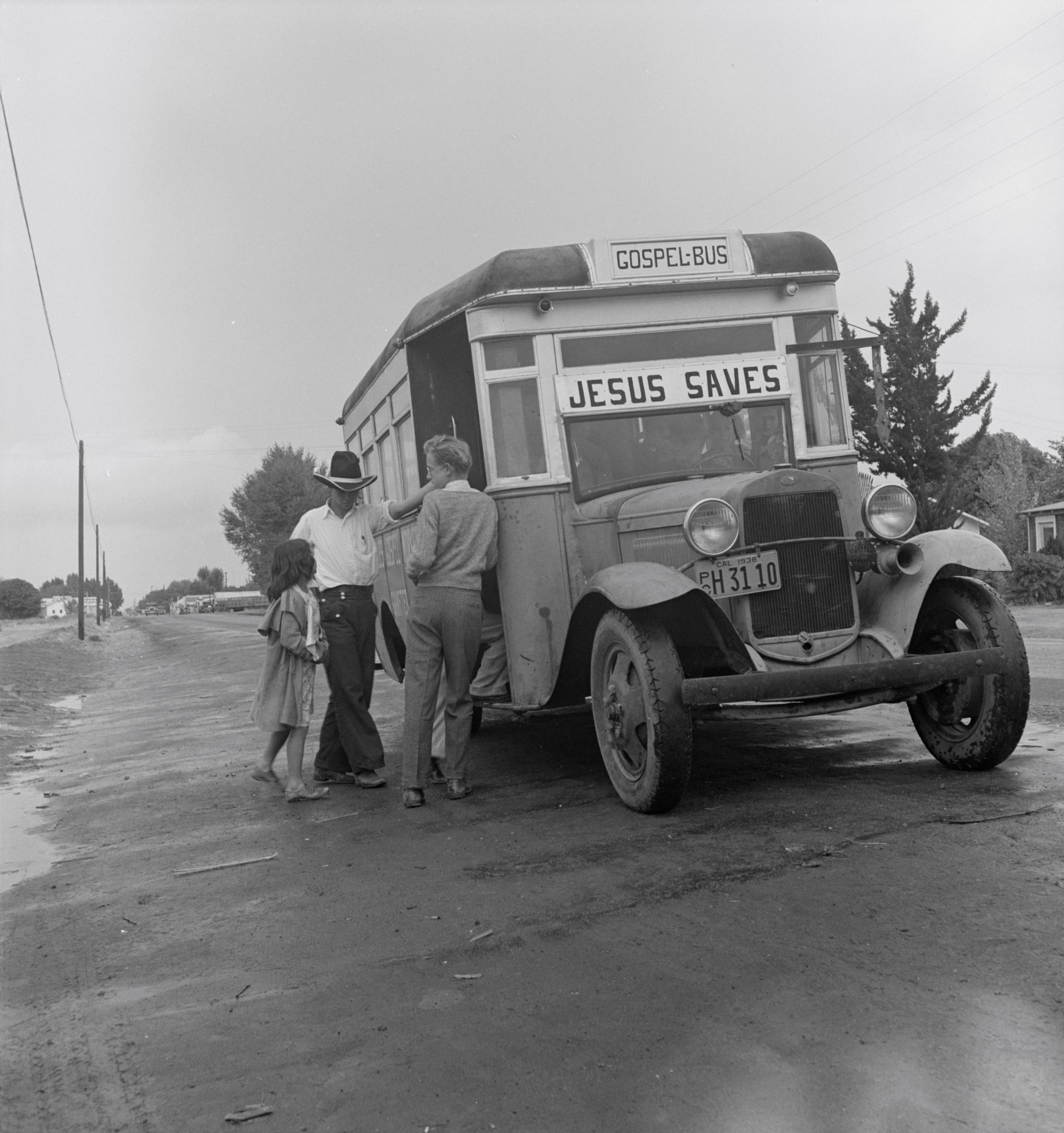Holy Rollers: Religion and Modern Mobility in the Art of John Steuart Curry
PDF: Richmond-Moll, Holy Rollers
In 1915, the creek beds around Dunavant, Kansas, had gone dry.1 That year a young John Steuart Curry (1897–1946) and his brother Eugene wandered from their family’s farm two miles down the road to the neighboring homestead of Will McBride (figs. 1–2). There he witnessed a local gathering of the Disciples of Christ—a Protestant sect then known as “Campbellites”—who were performing immersion baptisms in a barnyard cattle trough. As the artist later recalled, he and Eugene were “interested spectators at all immersion baptisms” around Jefferson County in those years. Such ceremonies “were usually held in the creeks,” Curry explained, “but at this particular time [in 1915] . . . the only available water suitable was in the tanks.”2 Thirteen years later, Curry summoned the event from memory to create Baptism in Kansas (fig. 3), the painting that brought him his first major critical and commercial success in the New York art world.
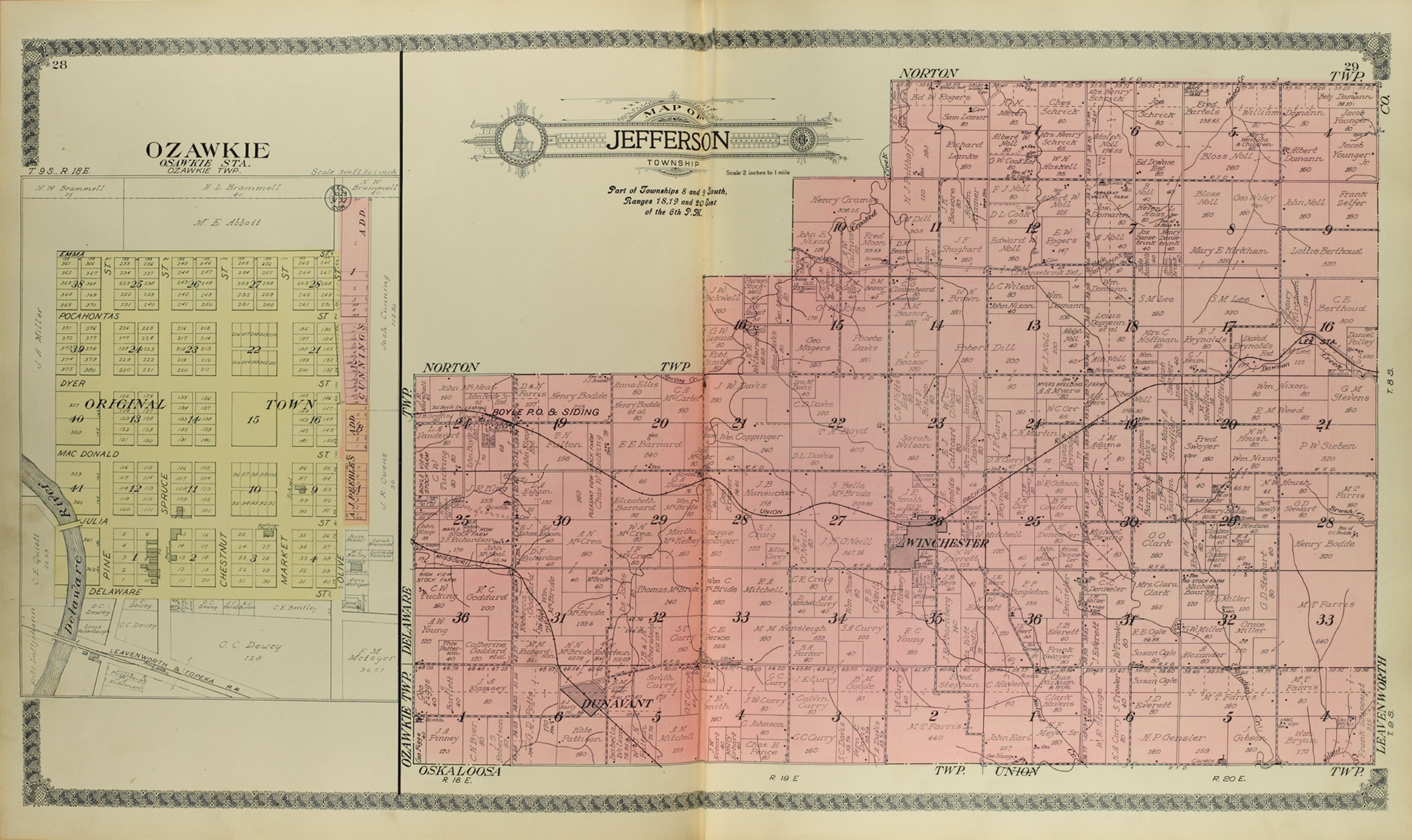

In Curry’s picture, a line of black Ford Model T’s encircles the exuberant farmyard ritual. The automobiles eclipse the farm’s more traditional machinery, from the horse-drawn cart beside the red barn in the middle ground to the metal plow sitting idle at right. Meanwhile, along the right edge of the picture, strands of electric wires and a long tan stretch of road recede into a distant horizon.3 Curry’s Baptism captures a period of revolutionizing movements in the early twentieth-century Midwest. In these years, new technologies and environmental shifts—including the very climatic changes that sent these Campbellites in search of water—would force the region’s residents to reorder their spiritual lives and radically rethink where religion and worship occurred.4

Baptism is the first in a series of four oil paintings and several related prints in which Curry reveals surprising intersections between two seemingly oppositional phenomena: “old-time religion” and modernized modes of mobility.5 Religion was central to Curry’s Kansas upbringing and undergirded his treatment of the Midwestern scene throughout his artistic career. Raised in the Scotch Presbyterian tradition, John and his family attended the Reformed Presbyterian Church in nearby Winchester, Kansas. While studying for two years at the Art Institute of Chicago, Curry wrote many letters to his mother, Margaret—who nurtured her son’s desire to become a professional artist—describing his weekly church attendance and interactions with other Christians, including at the city’s Moody Bible Institute.6 He then chose to attend Geneva College in Pennsylvania, a Reformed Presbyterian school, but stayed only twelve months, leaving for New York City in early 1920 to pursue a career in illustration.
Even after his affiliations with institutional religion waned in the late 1920s, Curry would continually point to the foundational influence of his early devotional life on his art. “I was raised,” Curry later told the art critic Thomas Craven, “on hard work and the shorter catechism.”7 Religion was, in fact, a key aspect of what Curry’s contemporaries considered to be his rare talent for expressing the monumentality of their moment. As fellow Regionalist Grant Wood remarked, Curry’s paintings have a “special faculty to see and express elements of universal significance in the life he has known.”8
Curry thus considered himself a painter of the “spirit” and “actualities” of American life rather than strictly a painter of religion. Yet Curry himself would admit that his religious upbringing similarly encouraged the artist to “discover in his surroundings a grandeur of action comparable to that of the children of the Old Testament”; to see the world and humanity’s elemental conflicts with nature as entangled with a longer religious history and with a divine purpose for the future.9 After all, as Roy E. Stryker, director of the Farm Security Administration (FSA)’s Historical Section, would instruct the photographers under his charge, religious life was real life.10
Curry’s choice of a Campbellite ceremony, and in particular a baptism, as his subject is especially important for conveying his underlying message that religious sentiment could help sustain physically displaced communities and for realizing his broader artistic project of presenting contemporary life as history in the making. The sacrament of baptism was fundamental within the Campbellites’ understanding of salvation, far more so than for most Protestant sects. As the denomination’s founder, Alexander Campbell, declared, “It is not our faith in God’s promises of remission, but our going down into the water that obtains the remission of sins.”11
Given the high stakes of immersion baptism among the Disciples of Christ, then, the accessibility of water was also crucial to the ceremonial life of its congregations, which explains why, in 1915, a caravan of Campbellites in Model T’s descended on the McBrides’ watering trough. As the denomination’s critics note, the Disciples of Christ espoused “a gospel of water, for upon its principles, without water there could be no salvation.”12 That year, as Curry later attests in his painting and as historical photographs reaffirm (fig. 4), the creek beds throughout the state had dried up, and cattle trough baptisms became common occurrences.
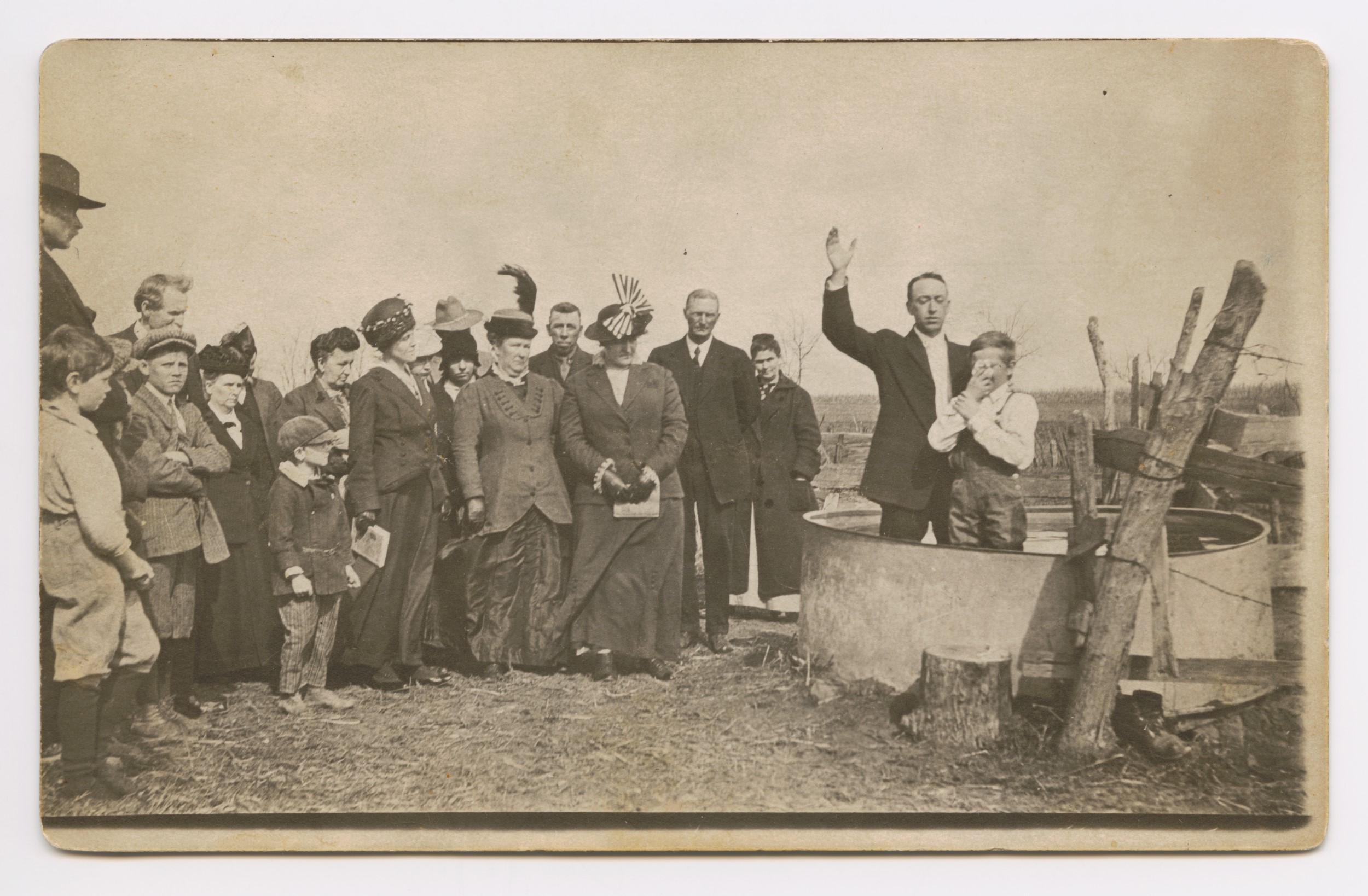
Campbellism’s dogmatic emphasis on immersion explains two of the more startling features of Curry’s Baptism in Kansas: the strange countenance of the minister performing the rite and its remarkable occurrence in a water tank on a farm. Dressed in black, with greenish-gray skin, a fiercely furrowed brow, and a dour expression accentuated by tensed cheeks and a downturned handlebar mustache, the parson looks more like the Grim Reaper than a joyful officiant as he twists his hips, grabs the young woman by the collar, and prepares to thrust her underwater. Curry’s rendering of the baptizer, however, plays into the metaphor of immersion baptism as a symbolic process of moving from death to life. The believer is first plunged below the water’s surface and then raised again from watery depths to “newness of life,” in the Apostle Paul’s words (Romans 6:4). Meanwhile, the birds hovering overhead in Curry’s painting reference the dove of the Holy Spirit that appeared above Jesus’s head following his baptism (Matthew 3:16), but the two-tone pair also echo the black-suited minister and white-robed neophyte as symbols of death and life, burial and resurrection.
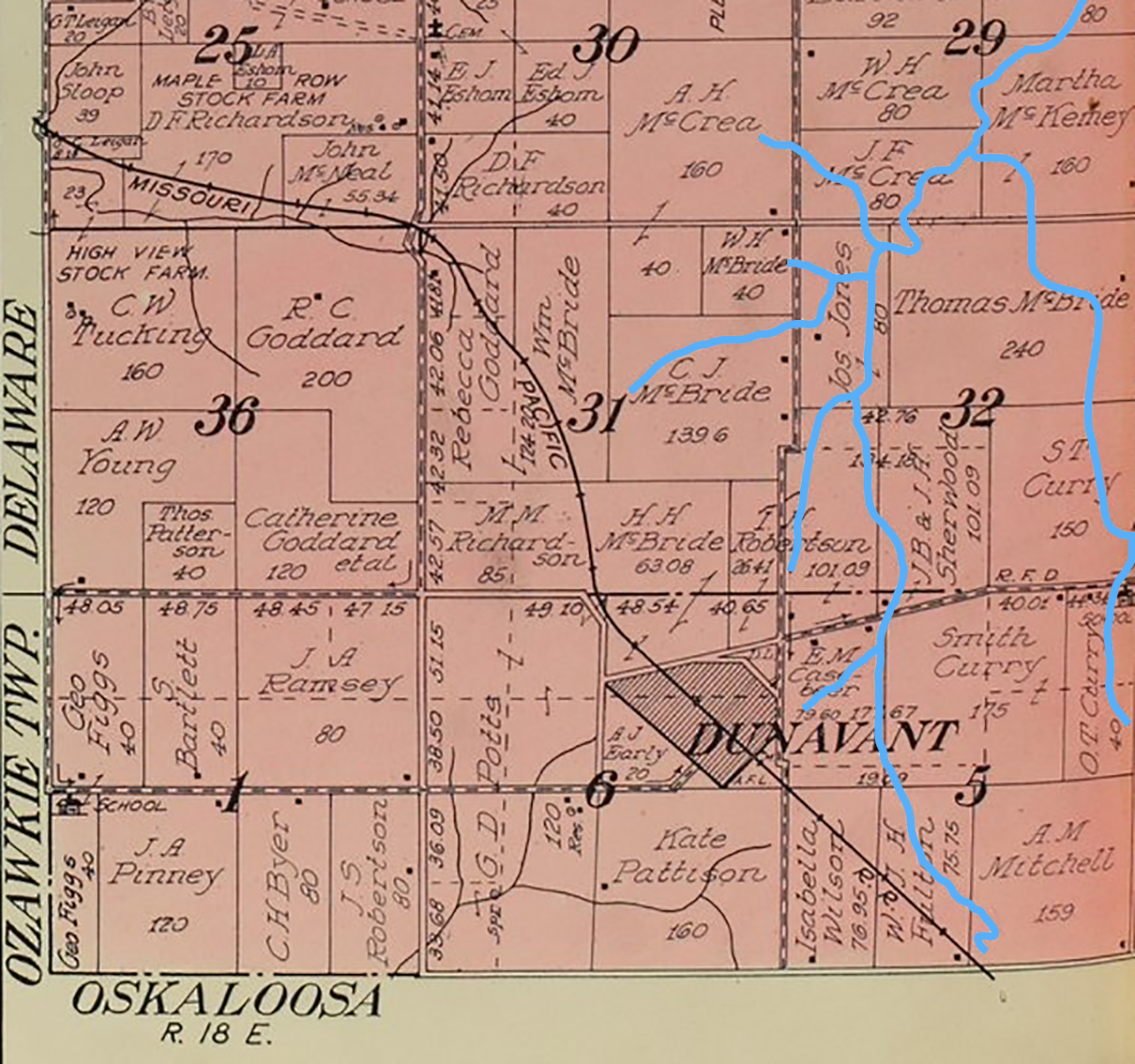
A 1916 map showing the farm plots around Dunavant also traces the branches of Big Stranger Creek (part of the Missouri River’s watershed), which pierced Will McBride’s property at its eastern edge and cut diagonally across the farmstead of his son, Clifford McBride, to the south (fig. 5). While Baptism in Kansas was painted from memory in New York in 1928, Curry’s return trip to Kansas in 1929 (funded, in part, by the success of Baptism after its public debut) would inspire a lithograph of a similar scene (fig. 6). Unlike in 1915, however, the creek beds of Dunavant were now flush with water. In the lithograph, a mass of worshippers and witnesses stand on its verdant banks under a lush canopy of trees beside a wagon and a Model T, while an assembly of novitiates, knee- and waist-deep in the stream, await their turn. The print captures these swelling waters because, before Curry arrived home that summer, Big Stranger Creek had risen far beyond its banks—expanding up to three miles in width in some spots—and caused significant damage to local crops.13

Baptism in Kansas, meanwhile, attests that, years earlier, such usual creek-side immersions were not possible, and local Campbellites were left with no choice but to locate an all-important baptismal font elsewhere. Curry’s hometown was located at the transition between verdant tallgrass prairies to the east and drier, less fertile territory further west, and therefore the town relied on unpredictable water sources, which made farming extremely difficult. Through their towering windmill, however, the McBrides hedged against the great fluctuations of Kansas weather, evident in the contrast between the debilitating drought seen in Curry’s 1928 oil painting and the devastating floods and rising water levels recorded in his 1929 lithograph. Windmills extracted water from hundreds of feet below ground, filling the kinds of troughs in which Curry’s baptism unfolds and making homesteads fit for farming.14 In the absence of surface water across northeastern Kansas, then, the two birds soaring overhead in Curry’s painting—a raven and a dove—take on further symbolic weight. These were the two birds Noah would release from the ark to determine whether the great Flood had subsided (Genesis 8:6–12). Ironically, in this period of drought, Curry’s birds herald the news—now disconcerting rather than hopeful—that there is no water to be found.
Baptism in Kansas thus demonstrates the relationship between climatic instability and the dislocation of local religious groups in this period. Curry’s choice to depict a faith community for whom baptism, and therefore water, played a central soteriological role highlights the volatility of the Kansas landscape and the displacing effects of water shortages across the Midwest. The ad hoc congregation takes their religion on the road to gather at the McBride farm amid drought conditions—the kinds of conditions that would later intensify during the period of the Great Depression and lead many to abandon their farms.
In this way, Curry’s Campbellite crowd is a canary in a coal mine. The painting foreshadows the more devastating environmental changes to come in the Dust Bowl. In Kansas in 1915, the modern car offered a way for religious communities to accommodate their rituals in response to drought. But, in later years, as FSA photographs like Dorothea Lange’s Tractored Out (fig. 7) would show, the promise of a modernizing Midwest—with its potent concoction of industrialized agriculture and automobility—ran headlong into its own environmental aftermath. The land and its farmers thus fell victim to these erstwhile beacons of industrial progress.15
Lange and other FSA photographers, like Russell Lee and Marion Post Wolcott, similarly recognized connections between American religion and dislocation. In photographs of the religious lives of migrant Midwesterners, Lange captures Holiness and Pentecostal communities that, having left behind their places of worship, nevertheless maintained their religious principles and continued to congregate for services, whether in a barn, a tent, or off the side of an automobile (fig. 8).16 Painted retrospectively, during the advent of new transportation technologies and widespread internal movements of populations, Curry’s Baptism draws on spiritual language to show how religion offered Midwesterners a stable sense of place, however momentary, in the midst of peripatetic experiences.
In his paintings and prints that deal explicitly with religious subject matter, Curry emphasizes discrete locales and distinct modes of conveyance in ways that also demonstrate the centrality of mobility to the project of American Regionalist painting. In opposition to the homogenization, standardization, and placelessness of American consumerism and urban life, Curry and his peers sought to rediscover and reveal the traditions and terrain of local, small-town American culture. As such, Regionalism ought to be understood as a mobile phenomenon.
This dynamic definition of the movement is in conflict with the strict geography and discrete sense of place that the name Regionalism implies. Curry, for one, asserted that a painter’s greatness is never geographically bound; Wood likewise found Regionalism “an unfortunate term,” connoting, as it does, “a rigid, geographical creed.”17 Instead, as each artist moved across space, Curry and his fellow American Scene painters sought the spirit of each place they pictured. Curry’s Regionalism was, by necessity, a peripatetic project in which an artist first initiated and then embraced the conditions of his own pictorial and professional nomadism. The “Middle West”—the birthplace of these painters—was, after all, something in the middle: something to which and through which one needed to travel. Along the way, painters like Curry encountered local populations that—in the course of their own, often involuntary displacements—were also seeking a spiritual, as well as physical, sense of place.
Unlike his better-known Regionalist colleagues, Thomas Hart Benton and Grant Wood, Curry depicts a Midwest that was bleaker, harsher, and more precarious, characterized by dislocation, emptiness, and boundlessness.18 This view of Curry’s oeuvre contrasts with predominant art-historical understandings of Regionalism as an “idealized vision of rural life” that was “meant to call viewers back to the farms and villages of an earlier, arcadian land that had already disappeared.”19 That the “arcadian” character of the Kansas landscape was rapidly disappearing (if it ever existed at all) would certainly not have been lost on the worshiping community in Curry’s Baptism. After all, their only recourse to performing this central Christian sacrament amid a severe drought was a Model T caravan to a farmyard water tank. And although Curry’s Baptism conjures a scene of bygone farm life, witnessed over a decade beforehand, his canvas also highlights modernity’s impact on and intersections with rural folkways.
Created in a period when itinerant Midwesterners were continually negotiating the modernization and transformation of their home region, Curry’s pictures suggest how religious belief could survive among—and even sustain—the displaced and dispossessed. For instance, scholars describe the claustrophobic crowd in the foreground of Baptism and the vacuous space of its prairie background as a joltingly incongruous juxtaposition. In the words of art historian Henry Adams, the viewer is at once “uncomfortably closed in” yet also “lost in topographical space.”20 But what if the claustrophobia of Curry’s prairie composition were interpreted as protective and preservative rather than paradoxical? What if this tight mass of participants in the foreground offers rural residents the temporary promise of a gathering place? How might rituals such as these have generated a congregation, a space of belonging, or a refuge for the many religious folks who continued to crisscross the vast Midwestern terrain on foot, on horseback, or on wheels?
As the first canvas in the artist’s decade-long series of religious pictures, Baptism epitomizes Curry’s pictorial approach to Midwestern spirituality and exemplifies a revised understanding of American Regionalism as a fluid, mobile endeavor. Curry’s painting vibrates with a sense of motion. His spiraling composition pulls the viewer into the center of the picture, curling counterclockwise, like a spinning wheel, from the young boy at bottom center and then along the rim of the trough past the inner circle of congregants, pausing at the balding man with an open Psalter at left. This centripetal trajectory resumes with the fragmented Model T just behind him, arcing back (this time clockwise) along the outer circle of black automobiles that hems in the crowd. The foamy blue, green, and brown water of the cattle trough swirls around the legs of the ashen-faced minister and the woman in white, who, in a moment, will be thrust beneath the surface. In short, Curry’s scene hovers in the tension between motion and stasis.
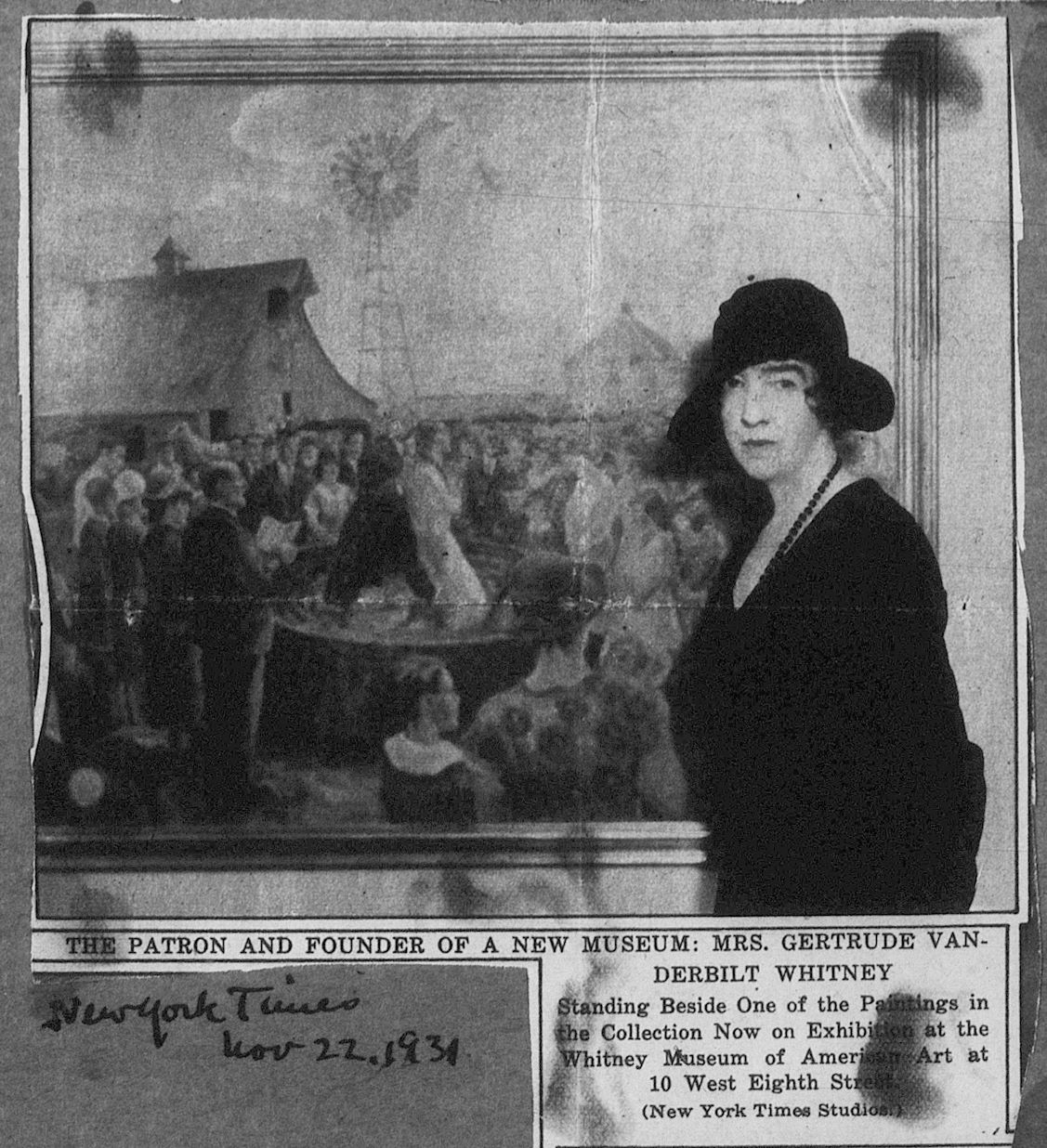
Curry submitted Baptism to the Corcoran Gallery’s Eleventh Biennial Exhibition of Contemporary American Paintings in the fall of 1928, where it quickly garnered widespread critical praise. The painting also won the attention of Juliana Force, director of the Whitney Studio Galleries in New York, and Gertrude Vanderbilt Whitney herself, who purchased the painting in 1930 for her fledgling museum. Force offered Curry membership in the Whitney Studio Club, with a fifty-dollar monthly stipend for two years, and Whitney would later have herself photographed beside Curry’s painting for a New York Times review of the Whitney Museum’s grand opening in November 1931 (fig. 9).
Despite this fanfare, critics at the time remained divided as to Baptism’s central message. Some saw it as a reverently nostalgic picture of rural spirituality. Artist and author Nathaniel Pousette-Dart claimed to find in this painting, which seems to have “sprung from the living,” “none of the cold sneering and aloofness” of other contemporary painters and writers in their treatment of the Midwest. “Curry not only understands these people,” Pousette-Dart continued, “he is one of them.”21 But others, like critic Edward Alden Jewell, called it “a gorgeous piece of satire,” showing the “religious fanaticism of the hinterland.” Apart from the “ontological portent” of the overhead clouds, Jewell suggested that the “inanimate” Kansas landscape simply looks on “as with a smile of cynical coolness,” its flat horizon “fenc[ing] from the outer world this shut-in frenzy of the human soul.”22
The satirical force of Curry’s painting is perhaps best discerned, however, by way of comparison with another image of a rural immersion baptism, created around the same time by fellow Regionalist painter Thomas Hart Benton. In a drawing from his Holy Roller Camp Meeting series, Benton depicts a baptism in a bottomland creek beside a cornfield (fig. 10), which he likely witnessed on a 1926 sketching excursion in the Ozarks of Missouri and Arkansas. Curry and Benton could not have known of one another’s baptism scenes prior to producing their own. Curry was in Europe at the time of Benton’s trip and would not meet him until a few years later. Benton, meanwhile, would not exhibit his Baptism until October 1929—one year after the premiere of Curry’s painting. That both artists were pursuing the same subject matter at the same time reveals the import of spiritual subject matter to the burgeoning field of American Scene painting and the centrality of religious ritual to any portrait of contemporary US culture.23
Benton’s drawing is more clearly critical of the frenetic faith of the devotees. A female figure, drenched in river water, stumbles dazedly onto the banks, her sopping hair across her face, helped along by a woman in a sunbonnet at front. Meanwhile, another woman is about to take the same plunge. One elder pulls her under, while the other smothers her face with his hand, awkwardly contorting her neck. The scene seems an ironic take on a ritual meant to symbolize rebirth and new life in the Christian faith, the men looking more murderous than salvific, and the newly baptized woman on the shore appearing more corpselike than resurrected. The sonic and gestural hyperbole of gaping mouths and upraised arms are another giveaway of Benton’s disdain for these religious traditions, whose “spluttering and shouting” he attributes in various writings to an out-of-control “Dionysiac madness.”24 From the ecstatic wailing of shut-eyed women and gaping-mouthed men to the twisting poses of the singers and the vortex of hydraulic energy swirling around the figures in the creek, to the church bell tower at the apex of the congregants, whose implied tolling echoes the spiritual noise of the group below, Benton’s Baptism amplifies the cacophony of the ritual with an overwhelming array of motion and sound.25
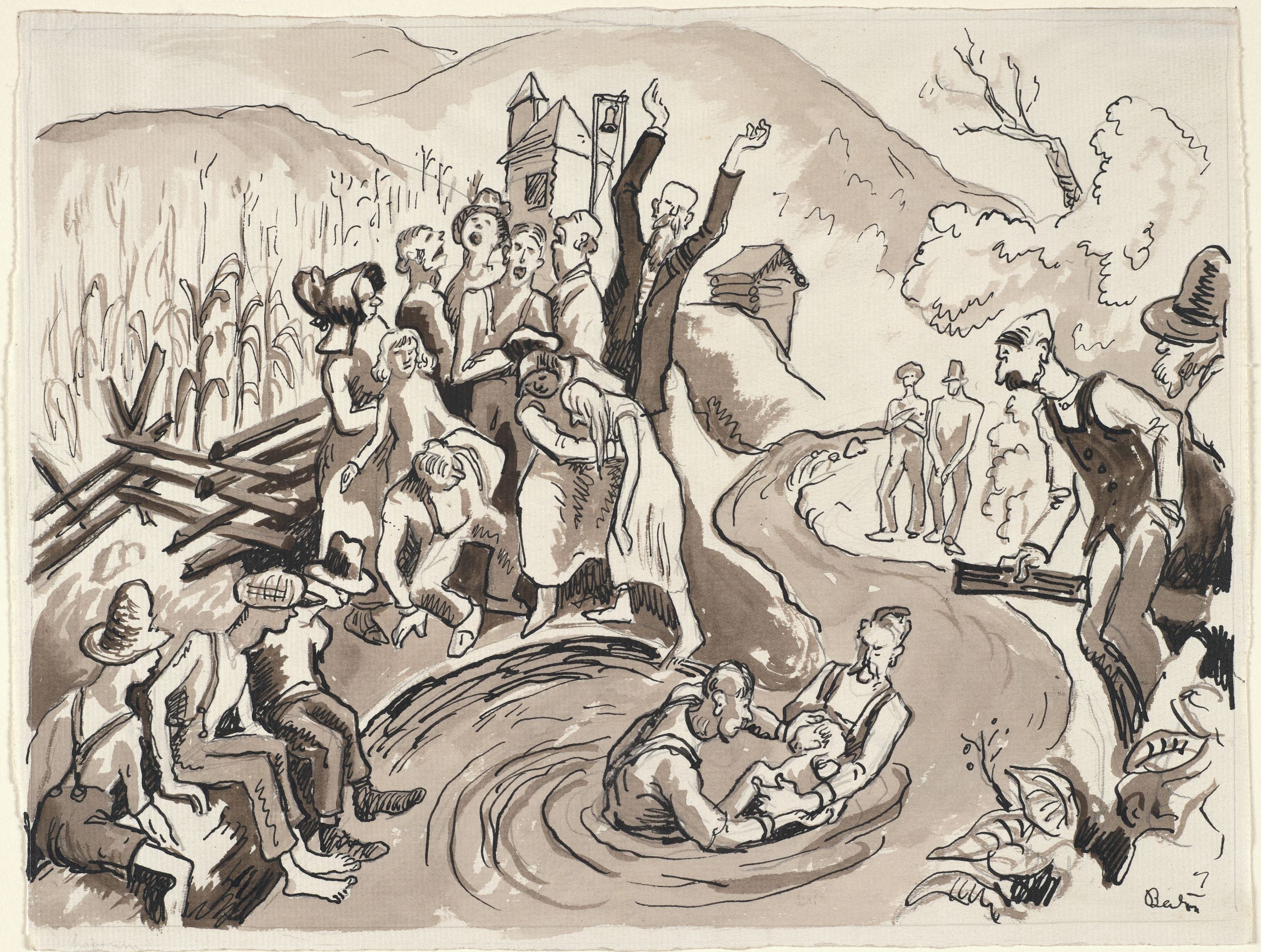
Considered alongside Benton’s rendition, Curry’s Baptism in Kansas appears less caustic and more earnest, regardless of how eccentric a watering-trough baptism might initially appear. This was, of course, Curry’s intention: to startle his East Coast viewers with the peculiar sight of a full immersion baptism—itself uncommon in the Northeast—performed not in a church or even in a river but in a farmyard trough under the open sky. Indeed, the apparently late-coming family in the foreground looks more like what Northeastern viewers might expect from a baptism ceremony, the baby’s white bonnet typical of christening outfits that infants might wear in a Presbyterian, Episcopalian, or Catholic church. Through their presence, as our vicarious interlocutors, Curry plays up the foreignness of this Campbellite event. And yet, as Curry attested, in Kansas and elsewhere outside the East Coast, such immersions were not “a strange procedure.”26 To the contrary, for most evangelicals across the South and Midwest, immersion baptisms were one of the most important ceremonies a Christian community could perform.27 For the Dunavant faithful, such baptisms certainly transgressed the boundaries of “normal” life, yet in a different way: within the pageantry of born-again Christian culture, the supernatural could erupt seamlessly within the course of everyday existence. To emphasize the satire of Curry’s scene, as recent scholarship has also done, at the expense of the relative historical accuracy of the picture is a way of reiterating the same elite Northeastern bias that Curry knew his painting would face in the late 1920s.
These complexities and contradictions prompt the question: what if there were a third way to read Baptism in Kansas that balances its satire with its sincerity? By focusing on new experiences of locomotion, like the automobile and good roads, alongside contemporary environmental shifts, Curry’s picture both acknowledges the strangeness of this barnyard event while also commenting on—what was then and might still seem so to us today—a paradox: namely the capacity of religion to navigate the technological and environmental instabilities of early twentieth-century life and of modern technology to facilitate old-fashioned religion.
In embracing “the historical struggle of man within nature” as the central theme of his art, Curry acknowledged that, for the people of Kansas, religious belief was inextricable from their perpetual strife with the land.28 As such, Baptism suggests that, with the rise of the automobile, religious groups, like the Campbellites, were increasingly capable of navigating these sorts of climatic displacements alongside their own devotional needs. If we look closely, we can see how Baptism is permeated by industrial modernity via not just the power lines and Model T’s but also the cloche hats, mail-order dresses, and knee-length skirts worn by the women around the trough.
By foregrounding modern industry in several of his religious paintings, Curry also accentuates the dynamic, exuberant nature of evangelical rituals. The artist did so most obviously in The Gospel Train (fig. 11), comparing the whirling movements and driving tempo of a Pentecostal gathering to the barreling energy of a steam engine. Such worship services earned Pentecostals the satirical appellation “Holy Rollers” in the early 1900s.
The moment Curry depicts in Gospel Train reinforces the artist’s dual emphasis on vernacular locomotive language and spiritual experience. Gospel Train captures the period in a Pentecostal service following a testimony. It was not unusual for Christians in this era to describe a conversion experience in locomotive terms or to liken the might of God to a barreling engine—and to do so particularly during the testimony period of the worship service, when the language of religion and everyday life most explicitly converged. As historian John M. Giggie observes, Black and white worshippers alike in the South and Midwest often characterized the “fear, excitement, and ecstasy” accompanying moments of religious conversion “by evoking the speed, steam, and bodily stress of traveling on a fast-moving train.”29 In Curry’s painting, the blonde woman in a light-blue dress beside the piano raises both arms, as if beckoning the spirit of the Lord—symbolized in the “Gospel Train” banner hanging at right, with its red locomotive pulling several Pullman cars—to roll down the tracks, across the wall, and into her expectant hands. Meanwhile, the screaming spotlights and arcing brushstrokes overhead reverberate into the darkness, like the headlamps of an oncoming train, this one a seemingly heaven-sent engine that bursts through the ceiling and into the service.
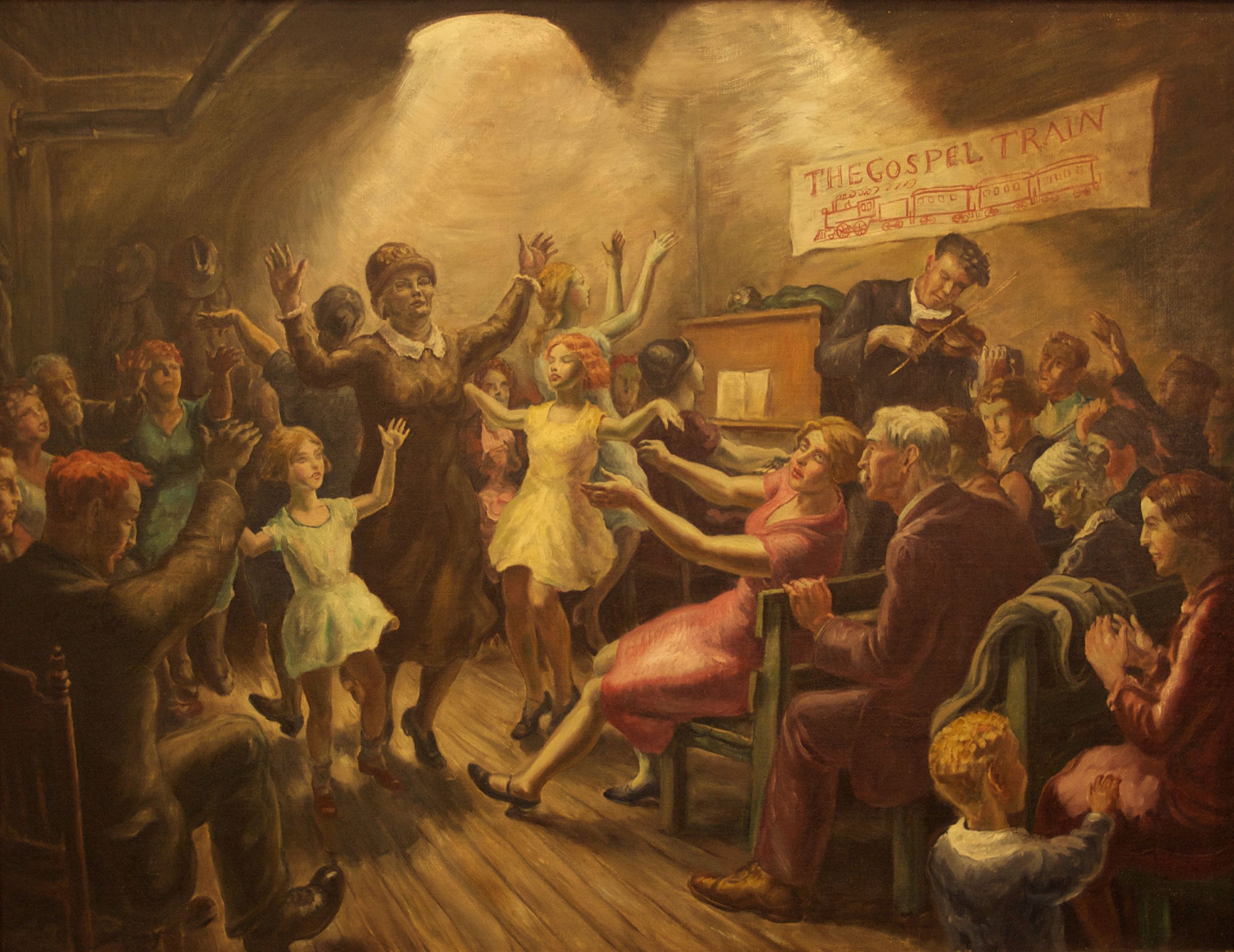
In this way, the locomotive language of the painting’s title, echoed both implicitly in the liturgical narrative and explicitly in the cartoonlike banner of a steam engine, conjures the migratory histories of Pentecostalism in those same years. The nomadic movements of Pentecostal congregations in the 1910s, ’20s, and ’30s paralleled—and frequently resulted from—the same climatic and technological displacements that forced the Campbellites into motion. With Gospel Train, Curry expands from the more localized movements of religious communities in Baptism toward the trajectories of religion on a wider, even national scale.30
Curry’s contemporaries similarly considered religion an important instrument of survival in uncertain times. Indeed, the industrial and environmental instabilities of the 1920s and ’30s showed that technology by itself could not save and protect Midwesterners. As one 1937 review of Curry’s paintings in the Kansas City Star notes,
Nor do the facts admit that men with machines, cities and commerce have at last outwitted Nature in Kansas. . . . What with depression, drought and mortgages, Kansas farmers of the 1930s have had as tough a time as those of the 1880s, discounting today’s motor cars, airplanes, electric lights and the radio, which can’t be eaten any easier than could the covered wagon or dugout walls.31
Modern technology alone, in other words, without religion and the possibility of spiritual supplication, offered Midwesterners little hope. For Curry’s fellow Kansans, any talk of the weather, the whims of nature, and humanity’s fight for survival was interlaced with the language of religion. Despite its retrospective narrative, painted over a decade after the events depicted, Baptism in Kansas was as much about America’s present and future as it was about a bygone era.
As Baptism in Kansas also demonstrates, new forms of transportation, like the car, were reshaping Midwestern life and religion in the 1910s and ’20s, altering the ways in which religious folk sought out and connected with spiritual communities. Especially after the release of the Model T in 1909, cars became items of mass consumption, and their numbers increased exponentially in rural markets like Kansas—from eighty-five thousand in 1911 to 2,146,512 in 1920, according to the federal Agricultural Census.32 That year, Kansas ranked third in the country for the percentage of farmers who owned automobiles (62 percent) and joined ten other states (all west of the Mississippi) in averaging 10.7 or more automobiles per hundred residents. The Good Roads Movement, meanwhile, established or expanded routes like Old Highway 59 to Kansas City, which appears in the background of Baptism and also rises behind the cattle yard and windmill in The Old Folks (Mother and Father) (fig. 12), a portrait of the artist’s parents seated in the parlor of their Kansas farmstead. Such arterial roadways networked rural Americans with the nation’s urban-industrial centers, just as the Kansas City Star newspaper on Curry’s father’s lap or the Atwater Kent radio behind his mother also connected rural residents with the world beyond the farmyard.
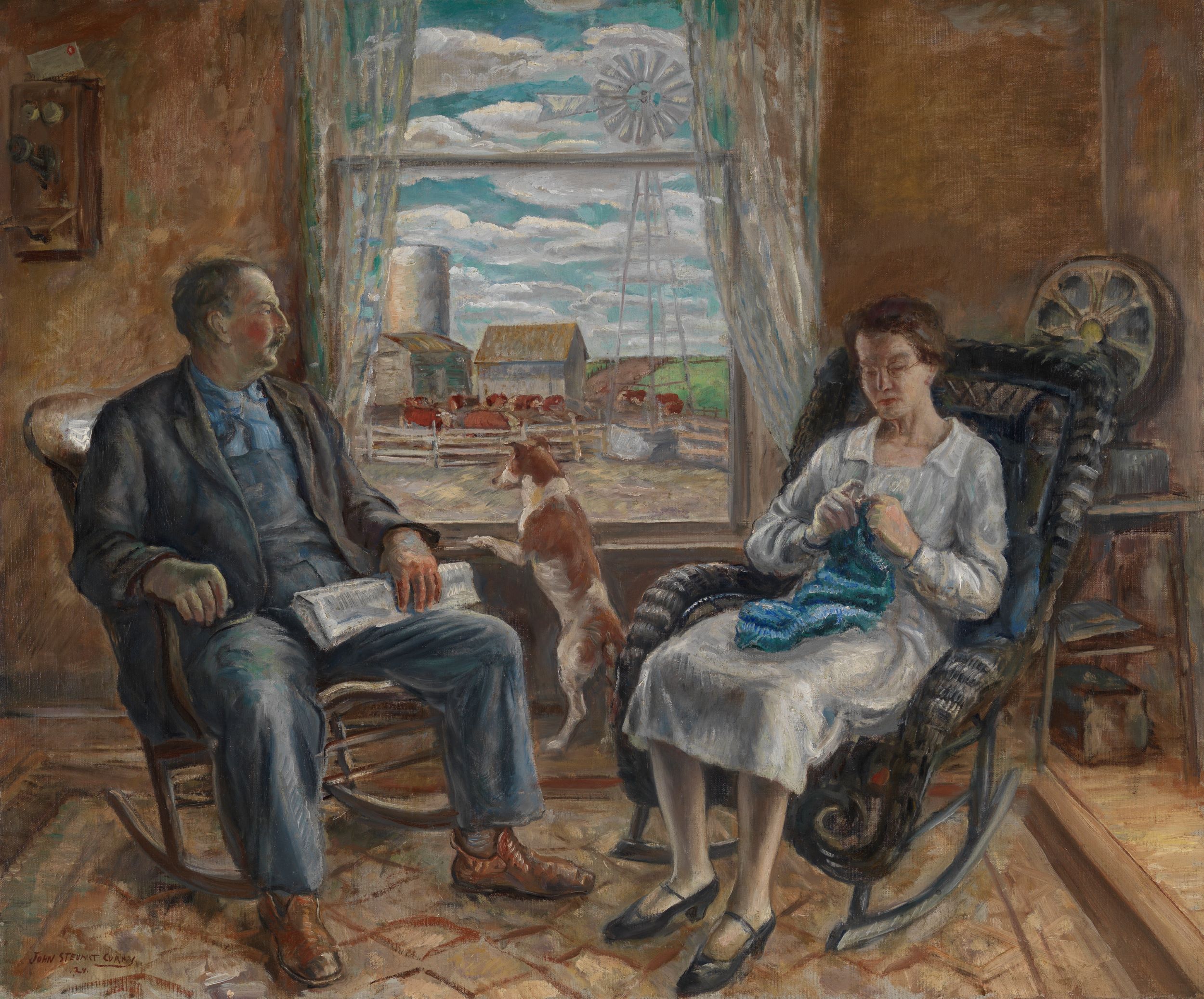
On one hand, then, automobiles and new roads offered novel ways to carry the faithful to religion, like the Campbellites in Curry’s painting, who converge on an unlikely watering hole for an “alfresco ceremonial.”33 The automobile, some pundits said at the time, could reduce the isolation of farm families. And as rural space became more centralized in larger villages, cars could also allow farm families to attend church on a more regular basis. In 1921, New Jersey politician E. C. Stokes wrote that cars and good roads could be “promoter[s] of good morals,” which yielded “a beneficent influence that makes for the good of American civilization. If every family in the land possessed an automobile, family ties would be closer and many of the problems of social unrest would be happily resolved. . . . The automobile is one of the country’s best ministers and best preachers.”34
The reality, however, was different. As a 1921 essay entitled “Motorizing the Rural Church” argued, cars played a chief role in the decline and disappearance of tens of thousands of old-fashioned rural meeting houses in the Midwest and the ensuing centralization of church communities in villages and towns.35 Now geography was no longer the primary determinant of where one worked, socialized, or worshipped. Curry’s birthplace of Dunavant, the site of his cattle-trough baptism, would be one such victim of rural modernization. In 1937, the Kansas City Star called Dunavant “a Kansas town ‘that was,’” the railroad and postal service having left, and numerous homes lying abandoned and in ruin.36 The following year, when speaking of Curry’s birthplace, Craven described “the eroded bones of a community killed by drought,” where automobile technology had quite literally erased the presence of local religion: “On the site of the Calvinist House of God stands a comfort station erected by an overland bus company.”37
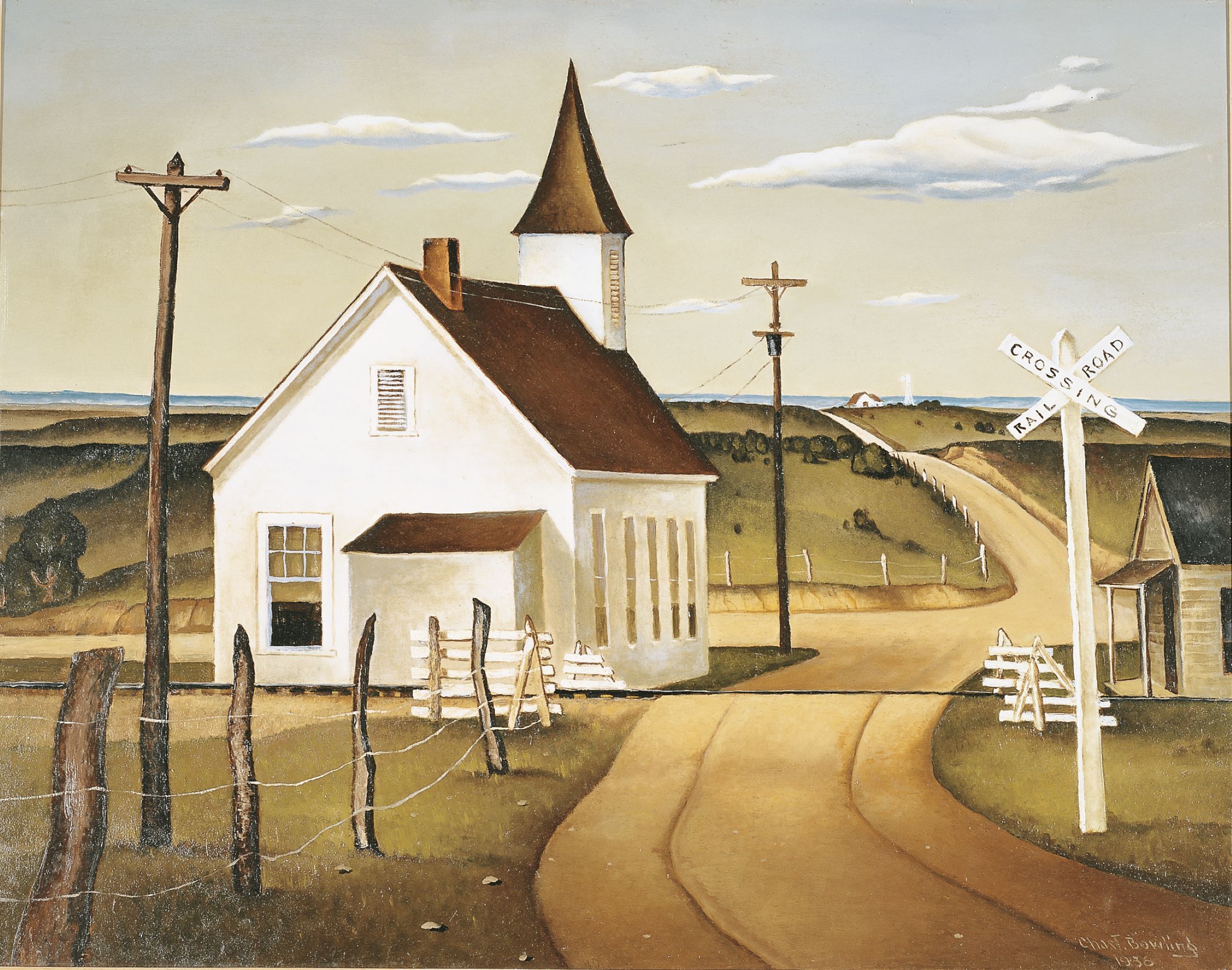
Artists likewise reminded their viewers that, even if roads may have led rural Americans to new places and possibilities, they also led people away from others in the process. Consider Charles T. Bowling’s Church at the Crossroads (fig. 13), with its simple wood-framed chapel standing at the corner of a dusty intersection. Barbed wire fences, utility poles, and whitewashed wooden barricades funnel the viewer down the rutted street into the distance, frustrating the possibility, in our imagined trajectory through the scene, of pausing at this church. While the utility lines sagging between two poles on either side the chapel may have connected this sanctuary to the larger power and telecommunications grid, their cruciform shape suggests that the saving power of modernization is eclipsing the redemptive capacity of traditional religion. As a draftsman and civil engineer with the Texas Power and Light Company, Bowling was keenly aware of the multiple ways that modern technology—electric wires, railroad tracks, automobiles, and new roads—would transform countryside landscapes, outmoding rural institutions, like the small white meetinghouse, in the process.

Rather than bringing unmitigated secularization, however, modernization in the Midwest meant that religion no longer required its more traditional structures—like the little white meetinghouse—to function. This era witnessed the rise of itinerant evangelists and nonresident ministers preaching on regional circuits, individuals who navigated—increasingly by car—between places with no organic relationships to one another (fig. 14).38 In Baptism in Kansas and subsequent religious-themed pictures, Curry likewise shows how the goings-on of Midwestern religion might occur in farmyards and storefronts, on creek beds and roadsides. As car culture took hold and as carts, cars, storefronts, and signs plastered with religious messages popped up along new roadways throughout the country, Curry’s paintings affirm what religious folk had long believed: that God could reach people anywhere, including in their cars and on their way from place to place.39
Cite this article: Jeffrey Richmond-Moll, “Holy Rollers: Religion and Modern Mobility in the Art of John Steuart Curry,” in “Reconsidering Art and Travel in America” (In the Round), ed. David Smucker, Panorama: Journal of the Association of Historians of American Art 9, no. 2 (Fall 2023), https://doi.org/10.24926/24716839.18179.
Notes
- Jeffrey Richmond-Moll is a member of Panorama’s Advisory Council. ↵
- John Steuart Curry to Margit Varga, February 28, 1942, John Steuart Curry papers (hereafter Curry papers), box 2, folder 57, Archives of American Art, Smithsonian Institution (hereafter AAA). ↵
- The automobiles in Baptism are very likely 1915 Ford Model T Touring cars with convertible tops. The profile of the grill and the design of the radiator front and shell match the 1915 version, as do the electric headlamps and curved cowl panel, which were newly introduced that year. If the recollected events of the baptism in Curry’s canvas occurred in 1915, then the cars in the painting were brand new models at the time. ↵
- Regarding the impact of other forms of technology on the religious lives of rural communities, see Tona J. Hangen, Redeeming the Dial: Radio, Religion, & Popular Culture in America (Chapel Hill: University of North Carolina Press, 2002), 4. For a recent study on the religious responses to ecological catastrophes in the 1930s Midwest, including among the evangelical Protestant sects that appear in Curry’s paintings, see Randall J. Stephens, “The Dust Bowl, the Depression, and American Protestant Responses to Environmental Devastation,” Church History 92, no. 2 (June 2023): 312–41. ↵
- The other works include The Gospel Train (see fig. 11); The Mississippi (1935; Saint Louis Art Museum), which originated as the lithograph Mississippi Noah (1932; Figge Art Museum, Davenport, Iowa); and The Ne’er Do Well (1929; Rex Sinquefield collection), which also existed as the lithograph Flight Into Egypt (1929; Figge Art Museum). ↵
- See, for example, Curry to “Mother,” November 12, 1916, Curry papers, box 1, folder 9, AAA. ↵
- Thomas Craven, “John Steuart Curry,” Scribner’s Magazine 103, no. 1 (January 1938): 37. ↵
- Grant Wood, “John Steuart Curry and the Mid-West,” Demcourier 9, no. 1 (April 1941): 4. ↵
- Craven, “John Steuart Curry,” 41. ↵
- Colleen McDannell, Picturing Faith: Photography and the Great Depression (New Haven, CT: Yale University Press, 2004), 18. ↵
- Alexander Campbell, quoted in William Phillips, Campbellism Exposed, or, Strictures on the peculiar tenets of Alexander Campbell (Cincinnati: Hitchcock & Walden, 1837), 20. ↵
- Phillips, Campbellism Exposed, 19. ↵
- Charles C. Eldredge, John Steuart Curry’s “Hoover and the Flood”: Painting Modern History (Chapel Hill: University of North Carolina Press, in association with the Morris Museum of Art, 2007), 37. ↵
- Henry Adams, “Space, Weather, Myth, and Abstraction in the Art of John Steuart Curry,” in John Steuart Curry: Inventing the Middle West, ed. Patricia Junker (New York: Hudson Hills, 1998), 117. This accounts for the soaring, salvific presence of the windmill. The tower stands like a steeple above the basilica-like red barn and sanctifies the Campbellite baptism, echoing the church and bell tower in the background of Giovanni Bellini’s famous Baptism of Christ (1500–1502; Chiesa di Santa Corona, Vicenza). For Curry’s use of Old Master precedents, see Lawrence Alloway, “The Recovery of Regionalism: John Steuart Curry,” Art in America 64, no. 4 (July–August 1976): 71. ↵
- See also Curry’s The Death of Ray Goddard (ca. 1939; private collection), in which Goddard’s lifeless body is carried away from the overturned remains of his tractor, suggesting the fatal potential of automobilized farming in the Midwest for both humans and the landscape. ↵
- McDannell, Picturing Faith, 31. ↵
- Wood, “John Steuart Curry and the Mid-West,” 2–3. ↵
- Adams, “Space, Weather, Myth, and Abstraction in the Art of John Steuart Curry,” 116. See also Patricia Junker, “John Steuart Curry and the Pathos of Modern Life: Paintings of the Outcast and the Dispossessed,” in Junker, John Steuart Curry, 151–64. ↵
- Judith A. Barter, “Prairie Pastoral,” in America after the Fall: Painting in the 1930s, ed. Judith A. Barter (Chicago: Art Institute of Chicago, 2016), 29. ↵
- Adams, “Space, Weather, Myth, and Abstraction in the Art of John Steuart Curry,” 120. ↵
- Nathaniel Pousette-Dart, “John Steuart Curry: A Kansas Painter Who Is Typically American,” Art of Today 6 (February 1935): 7. ↵
- Edward Alden Jewell, “Eleventh Corcoran Exhibit and German Primitives: Fine American Showing,” New York Times, November 4, 1928, 12. ↵
- Regarding the constitutive role of religion within the project of US modernism, see Erika Doss, Spiritual Moderns: Twentieth-Century American Artists and Religion (Chicago: University of Chicago Press, 2022); Jeffrey Richmond-Moll, “Routes/Roots: Religion and Modern Mobility in American Art, 1900–1935” (PhD diss., University of Delaware, 2019). ↵
- Thomas Hart Benton, An Artist in America (1937; repr., Columbia: University of Missouri Press, 1983), 100. ↵
- The violence against female initiates in Benton’s drawing also evokes the gendered dynamics of charismatic Christian religion. Here, too, Curry’s scenes of Midwestern religion provide an alternative, in which women of all ages participate prominently. The stature of the older woman at left in Baptism, who presides over the ritual and who sits (not coincidentally) in the driver’s seat of the car, underscores how, even within otherwise marginal and maligned Protestant sects like Pentecostalism, women held formal leadership positions and served important social and spiritual roles. See Richmond-Moll, “Routes/Roots,” 364–65. ↵
- Curry to Varga, February 28, 1942, Curry papers, box 2, folder 57, AAA. ↵
- McDannell, Picturing Faith, 100–101. ↵
- John Steuart Curry, “Description of Murals for Kansas State Capitol,” n.d., n.p., Maynard Walker Gallery records, reel 2159, frame 804, AAA. ↵
- John M. Giggie, “The Mississippi River and the Transformation of Black Religion in the Delta,” in Gods of the Mississippi, ed. Michael Pasquier (Bloomington: Indiana University Press, 2013), 116. ↵
- For an expanded analysis of Gospel Train, see Richmond-Moll, “Roots/Routes,” 362–73. ↵
- “Curry and Kansas—A Story of Heroic Life,” Kansas City Star, August 22, 1937, Maynard Walker Gallery records, reel 2160, frame 170, AAA. ↵
- Department of Commerce, 1920 Agricultural Census, in Facts and Figures of the Automobile Industry (New York: National Automobile Chamber of Commerce, 1929), 82. ↵
- Craven, “John Steuart Curry,” 40. ↵
- E. C. Stokes, “The Family Car,” Motor 35, no. 19 (February 1921): 157–58. ↵
- O. R. Geyer, “Motorizing the Rural Church,” Scientific American, May 14, 1921, esp. 385, 395, 397. ↵
- “Curry and Kansas.” ↵
- Craven, “John Steuart Curry,” 37. ↵
- Michael L. Berger, The Devil Wagon in God’s Country: The Automobile and Social Change in Rural America, 1893–1929 (Hamden, CT: Archon, 1979), 128–29. ↵
- McDannell, Picturing Faith, 106–8. ↵
About the Author(s): Jeffrey Richmond-Moll is the George Putnam Curator of American Art at the Peabody Essex Museum in Salem, Massachusetts.



